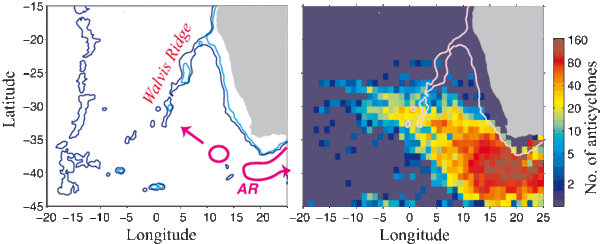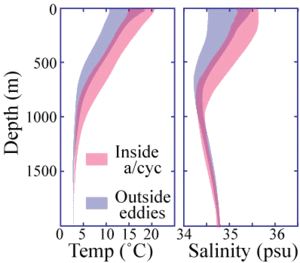Mixing Argo and altimetry to estimate salt
Image of the Month - November 2010
(left) Area of the Agulhas Retroflection (where the current abruptly turns around) and shedding of eddies. (right). A census of anticyclonic eddies computed from altimetry, noting that a feature counts separately for each week it is present. A large number of such eddies are near the Agulhas Retroflection and along the route north-westward from there across the Walvis Ridge (Credits NOCS)
South and west of South Africa, warm salty waters from the Indian Ocean come into the Southern Atlantic, mostly within eddies generated at the Agulhas Retroflection (rather than through the mean currents). This exchange of heat and salt between the two oceans is important in the general circulation, and especially the conveyor belt. But it is hard to quantify it from in situ measurements due to their limited coverage (while satellites can't observe below the surface).
However, by combining in situ Argo floats, and altimetry satellite observations, it is possible to categorise if an Argo float profile is measured within an eddy, or if it represents the background conditions. And thus estimate the heat and salinity transport by eddies, and monitor the changes of Agulhas eddies as they migrate northwestwards. The results of such a study show that Agulhas eddies over the top 800 m are typically warmer (by 3°C) and saltier (by 0.4 psu) than their environs. As the waters migrate northwestwards, a gradual reduction in the anomalies near the surface can be seen. A major part of this is due to the change in background conditions, as the eddies move into a region towards the Equator where surface waters are warmer and saltier. However, some of the change is due to surface heat loss being mixed down within the eddy.
See also:
- Applications: <link en applications ocean large-scale-circulation index.html _self internal-link>Ocean large-scale circulation
- Image of the Month, September 2010: ASAR vs altimetry South of Africa
- Data: Ssalto/Duacs near-real and delayed time multimission altimeter products
Other web site on this subject:
- Coriolis web site (Argo data)
- Satellite Observations of the Agulhas Current System (NOCS)
References:
- G.D. Quartly, J. Georgiou, M.A. Srokosz, 2010: Estimating the Indo-Atlantic salt flux from Argo and altimetry, ESA Living Planet Symposium, Bergen, 28th Jun-2nd July 2010, ESA SP-686






